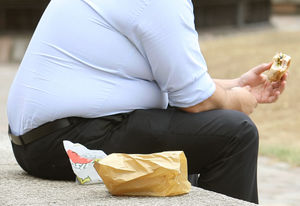What is making us so fat?
Move more and eat less, goes the old mantra about losing weight.

But as parts of Shropshire teeter on the brink of an obesity crisis, it appears that it might not be quite as simple as that.
And Prof Ralph Early, head of food science at Harper Adams University, warns that junk-food manufacturers are using subtle techniques to sell us more unhealthy food in the same way that animal feed manufacturers fatten livestock.
"Just as some farm animal feeds are formulated with flavours to encourage rapid consumption and weight gain which is good for market prices, so junk-food manufacturers work to create foodstuffs with flavours that are irresistible," he says.
"But consume too much too often, and in the long run your health will pay the price."
Of course, making food taste better is hardly a crime. But it is the way some sectors of the industry invest millions of pounds developing moreish – some would say addictive – foodstuffs with little nutritional value that is causing concern among some experts.
While excessive food consumption and sedentary lifestyles are commonly blamed for obesity, their is evidence to suggest this is not the case.
While obesity has doubled since the 1980s, and the average Briton is three stone heavier than in the 1960s, food consumption has actually gone down. Government statistics show the UK now consumes an average of 2.13 million calories a day, down from 2.59 million in 1976.
As for the sedentary lifestyles being to blame, again, this is highly questionable. Research by the International Journal of Surgery found that adults doing manual work were four times more likely to be morbidly obese than those in professional employment.
In other words, eating less and moving more does not appear to make us slimmer.
So what is the cause of growing obesity?
Campaigner and journalist George Monbiot points out that while we now eat less than we did 42 years ago, it is what we eat that is causing the problems.
He says: "Today we buy half as much fresh milk per person, but five times more yoghurt, three times more ice cream and – wait for it – 39 times as many dairy desserts.
"We buy half as many eggs as in 1976, but a third more breakfast cereals and twice the cereal snacks; half the total potatoes, but three times the crisps."
He points out that many of these foodstuffs are loaded with sugar and other addictive flavourings.
However, endocrinologist Roger Lustig says there is a bigger problem than the normal sugar most of us are familiar with. And it originates from the wholesome-looking cornfields of the United States.
In order to make use of bumper corn harvests in the 1970s, the US food industry developed a cheap sweetener known as high-fructose corn syrup (HFCS).
Endocrinologist Robert Ludwig says the problem with fructose is that, compared to regular sugar, it is more easily converted to fat in the body. More worryingly, it suppresses the action of a vital hormone called leptin which tells us when we have had enough.
“Leptin goes from your fat cells to your brain and tells your brain you’ve had enough, you don’t need to eat that second piece of cheesecake,” he says.
“It makes your brain think you’re starving and now what you have is a vicious cycle of consumption, disease and addiction. Which explains what has happened the world over."
Public Health England PHE, as part of a government plan to cut childhood obesity, set a target of reducing sugar contact in a range of products by 20 per cent by 2020. This included an 'ambition' to cut sugar content by five per cent by May this year.
The 'ambition' was not, met, with sugar content being cut by just two per cent, although the PHE described it as an 'encouraging start'.
PHE chief executive, Duncan Selbie, says: "We have seen some of the food industry make good progress, and they should be commended for this. We also know that further progress is in the pipeline.
"However, tackling the obesity crisis needs the whole food industry to step up, in particular, those businesses that have as yet taken little or no action."
The food industry insists it is committed to supporting efforts on reducing obesity.
Tim Rycroft, chief executive of the Food and Drink Federation, says: "As PHE correctly point out, reformulation takes time, it can't happen overnight."
He says sugar plays a variety of roles beyond adding sweetness. It is used to give colour, texture and consistency to foodstuffs.
"It is for these reasons that we have long said that the guidelines are ambitious and will not be met across all categories or in the timescale outlined," says.
“Obesity poses a huge public health challenge in the UK, and food and drink companies are well aware of their role in addressing this issue. "For the last decade the UK's food and drink companies have been reformulating their products to reduce sugar, calories, fat and salt, as well as limiting portion sizes. In fact, over the last five years FDF members have reduced calorie content in the average basket by 5.5 per cent, and sugar content by 12.1 per cent – and there is more work in the pipeline."
Prof Early is sceptical, and warns it is a problem that is going to be difficult to tackle.
"The UK food marketplace is oversupplied and some food businesses specialise in providing energy dense low nutrient foods which they market in ways that encourage over-consumption," he says.
"Additionally, it appears that there may be an epigenetic effect, meaning that poor dietary practice leading to diet related disease by one generation can lead to the modification of chromosomes with the problem passed to the next generation.
"It's actually quite a complicated, multi-factorial subject and one which is only now being researched properly."




